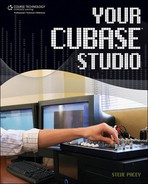Understanding an Analog Mixing Console
All mixers have two basic sections: the input and the output. Most analog recording mixers have another basic section known as the monitor section. Most mixing consoles appear very similar to the virtual mixer in Cubase. The most widely recognized section of the mixing console is the input section. The input section is where everything (instruments, vocals, tape machines, etc.) interfaces with the mixer. In this section each instrument receives its own channel of gain, EQ, volume, and pan. The output section is where the input’s signal gets routed to its final destination within the console itself. The output section (of a console) includes master outputs as well as group (bus) outs. These outputs usually direct the sound to a recording source, in your case your computer’s sound card and Cubase.
Note
Even though Cubase 4 allows you to record up to 256 tracks simultaneously, you will most likely be limited by the number of outputs on your mixing console, the number of inputs on your sound card, and your computer’s overall capabilities.
The monitor section of a mixing console is strictly designed as a sub-mixer within the mixing console, and its sole purpose is to enable you to hear the inputs without using the output section. The monitor section was originally intended to enable you to hear the signal as it was coming from the recorder so you could hear what the final sound would be.
Because there are a tremendous number of possibilities for signal routing, I’ve used a popular 24-channel mixing console, the Mackie 24x8 (see Figure 7.3), and 24 channels of a popular sound card, i.e. three PreSonus FP10 FireWire recording interfaces chained together (see Figure 7.4), to demonstrate one of the most complex home-recording setups imaginable while simplifying it as much as possible. I won’t go into great detail on how to operate the hardware. You’ll need your hardware manuals for that. Instead I will go into great depth on hardware configurations for your Cubase studio. Most of these configurations will work with other DAWs as well, but I will address some points specific to Cubase.
Figure 7.3. The Mackie 24x8 recording console.

Figure 7.4. The PreSonus FP10 (8 inputs, chain enabled, rackmountable) FireWire sound card.
The Mackie 24x8 is a somewhat large, lower-cost analog recording console. Most digital mixers (both hardware and software) have been modeled after the classic analog mixer. Using the following scenario, you should be able to compare how settings can be made with many other mixers available on the market, regardless of whether they’re analog or digital.
I’ve told you about the equipment; now here’s the scenario. You will be recording a seven-piece band: a singer, an electric guitar player, a bass player, a drummer, a percussionist, a keyboardist/pianist, and an acoustic guitar player. To make things more difficult, check out this nightmare list of things they require as they play live:
The band will be playing with 12 prerecorded tracks that they must be able to hear.
The drummer needs a loud click track, but the rest of the band will not be using a click, and they don’t want to hear it in their monitors.
The drummer will be playing an all-acoustic five-piece kit with a hi-hat and three other cymbals.
The keyboardist brought a rack of seven synths (two of which have multiple outputs) and has prerecorded 18 MIDI tracks that the band will need to hear when performing live.
The keyboardist will also be playing a grand piano and singing backup vocals during the take.
The acoustic guitar player will also be singing backup.
The electric guitar player brought a guitar amp that is wired in stereo and wants to hear and record both sides of the stereo signal.
The singer needs to hear reverb on his voice when he sings but would like to record the vocal dry.
The percussionist is using an electronic percussion pad and would like to record the MIDI live. At the same time, she will also be playing live tambourine and singing backup vocals.
The bass player would like to record both a direct signal and a miked signal from the bass.
Besides the control room in your home Cubase studio, you have a living room with a piano and a bedroom. Luckily, you also have a few closets, a portable vocal isolation booth, and a few homemade studio baffles.
First of all, don’t panic. This is a complicated setup even in a professional studio, and hopefully you won’t be doing anything this crazy. However, if you’re recording a lot of bands, you will run into quite a few of these technical issues.
